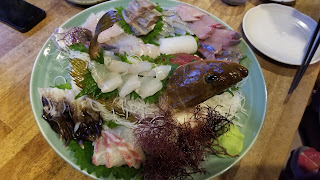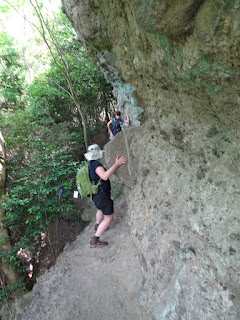 |
| At Shiratani Unsuikyo gorge |
Officially one of the wettest places in Japan, it gets over 13 feet of rain per year. We got to experience that on our first day of hiking.
 |
| This makes Olympic National Park seem very arid and sparce |
It was hard to decide whether to get wet from sweating in our rain gear, or wet from the warm rain. Either way we got wet, but we smelled better with the rain method. But we didn't care because it was so beautiful and we had to watch our footing.
 |
| Our slippery path in many parts |
 |
| One of many old cedars |
 |
| A mother stump |
Giant cedars, some over 2,000 years old dotted the path. Others were gigantic stumps, giving birth to more trees of differing species. Many of them were logged over 1,000 years ago by peasants, paying their taxes to feudal lords in cedar shingles, rather than rice. Getting them down the mountain to the coast was quite an undertaking, and we walked along some of their "sidewalks."
 |
| Ancient "sidewalks" used by women carrying shingles cut by the men |
 |
| One of many bridges |
 |
| So many waterfalls, only so much room to post them here |
 |
| One of the areas where Disney artists meticulously copied for Princess Mononoke |
 |
| View from Taikoiwa (Thunder) Rock |
We descended the peak to a beautiful river where some of us went for a swim in clear, icy water. Then we followed an old narrow-gauge logging track back to waiting vans.
 |
| Deep, clear, and cold swimming hole with azaleas |
 |
| The Japanese version of rails to trails |
 |
| Part master chef, part entertainer |
The hosts at our traditional inn (a royakan) went out of their way to prepare us a feast each night with stuff we hadn't had before, like barnacles, pigs feet, and bamboo shoots. Smooth jazz played in the background. The proprietor was quite the fun-loving character.
 |
| This was taken before the pigs feet arrived |
 |
| A feast of feasts! |
 |
| View from our inn and our hot soaking room |
Yesterday we returned by plane to Kirishima on the Island of Kyushu, with the intention of exploring the crater lake of Onami, 4,200 feet above sea level. However a series of eruptions closed the area off. We actually heard one and saw the plume. So we walked around a shine, one of oldest in Japan, with some remnants dating back more than 2,000 years ago. Kind of anti climatic, but we got an early start to our soaking and our farewell partying.
 |
| outside the party room |
 |
| After our last hike on our 12th day of hiking. Is this a civilized country, or what! |
This turned out to be a wonderful trip, both our first independent part and with the Sierra Club hiking part. Lots of physical activity, unique things to see, unusual food, fun and compatible traveling companions, and a hospitable country. We made some new good friends. Above all, we had two outstanding local guides from Walk Japan and two well-organized volunteer trip leaders from the Sierra Club. Thanks, everybody for making everything so fun and special!
 |
| Volunteer leader Todd, local guide Mario, volunteer leader Joyce, and local guide Ben. Mario was born here, educated in the States. Ben moved here from the UK abut 11 years ago. |
Be sure to catch my next blog in a few days entitled "Japan Between the Cracks." It will be about things we found unusual or interesting, but that didn't fit the narrative of the previous blogs. I promise you it will be a fun read.































